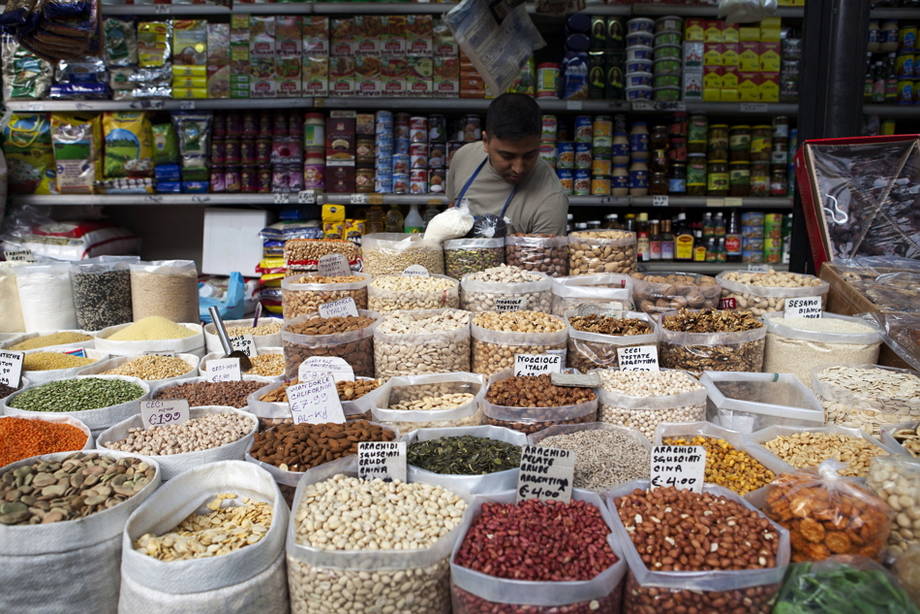Italy sponsors event at FAO showcasing how legumes can contribute to Sustainable Development Goals
“Pulses are good for people, and are good for soils,” Eduardo Mansur, the head of FAO’s land and water division, said today at an event that highlighted the promising future of edible seeds such as lentils, chickpeas and pigeon peas, all often neglected in the shadow of the world’s major staple grains.
The event – “Soils and pulses; symbiosis for life” – was sponsored by Italy’s permanent representation to FAO, led by Ambassador Pierfrancesco Sacco, along with Bioversity International and FAO itself, and drew a strong link between the International Year of Pulses and the 2030 Sustainable Development Agenda.
Participants highlighted how pulses offer exceptional nutritional inputs to human diets, are economically affordable, use relatively little water compared to other protein sources, and also reduce the need for industrial fertilizers. They are even gluten-free, Mansur noted.
Feeding iron-rich lentils to Sri Lankan children for 60 days led to a drastic 90 percent increase in their blood profiles, showing remarkable efficacy for anaemia and other malnutrition issues in developing countries, according to the keynote speech from Mahmoud Solh, Director General of the International Center for Agricultural Research in the Dry Areas (ICARDA).
Pulses can also fix hefty quantities of nitrogen in the soil, boosting fertility and reducing – by millions of tonnes globally – the need to apply the key nutrient for food crops. Fava beans are the champions in this regard, but even dry beans can add up to 70 kilograms per hectare, Solh said. He spoke via video link from Marrakech, where ICARDA and FAO are hosting a workshop promoting pulses in African agriculture.
Paola De Santis, a researcher at Bioversity International, showcased research her organization is doing in Uganda, China and other countries on improving bean seed quality to enhance productivity as well as genetic diversity of key pulses varieties, which can be leveraged to boost plant resistance to diseases and pests.
Pulses also have huge potential in wealthy nations, due to environmental and health concerns. Michele Pisante, from Italy’s Council for Agriculture Research and Agrarian Economics (CREA), noted experiments showing that rotating legumes with grain crops could save up to 88 kilograms of nitrogen per hectare in Europe, where fertilizer use is high by international standards. There has been a sharp global reduction in pulse production compared to cereals since 1962, and reversing that would lead to virtuous outcomes including lower carbon costs per unit of glucose, Pisante noted.
Pulses and policy
Other participants pointed out that pulses typically offer farmers higher profit margins than cereal grains and can thus play a key role not only in boosting human and ecological health but also in helping reduce rural poverty.
“Agriculture is increasingly strategic in our daily lives,” said Aydin Adnan Sezgin, Turkey’s permanent representative to FAO and co-chair of the International Year of Pulses Steering Committee.
Possible policy measures were also discussed. Several panellists noted the potential role for agricultural subsidies in favour of pulses, along the lines of those in broad use for grains. The particular role of smallholders, however, warrants special attention at a time when food systems and supply chains are increasingly intertwined, said Wafaa El-Khoury, a specialist at the International Fund for Agricultural Development (IFAD). Without interventions, productivity enhancing skills may be more available to larger farm enterprises, pushing family farmers onto marginal lands, she said.
The International Year of Pulses offers a platform to highlight issues that can make great contributions to the Sustainable Development Goals, including those of eradicating hunger, promoting health and assuring access to clean water, Italian Deputy Minister of Agriculture Andrea Olivero said in his closing remarks. “Both consumers and producers would benefit from more information,” he added.
via FAO

